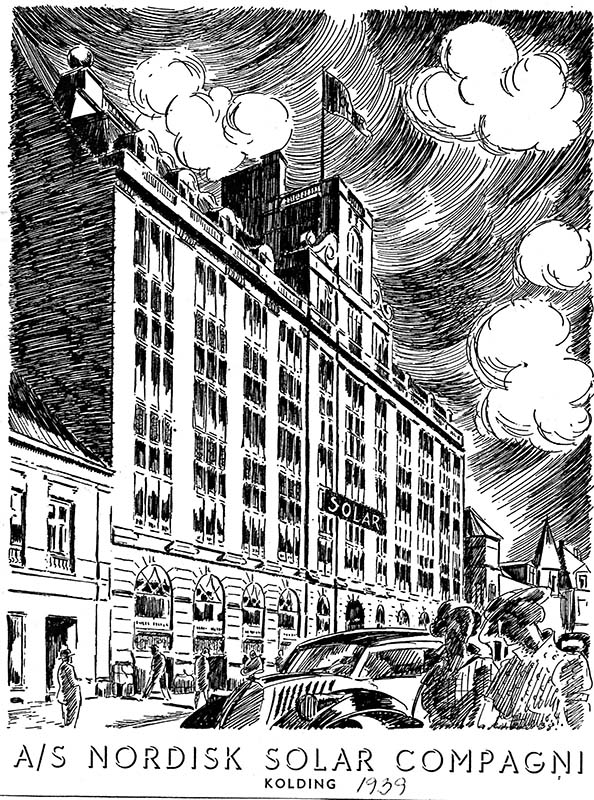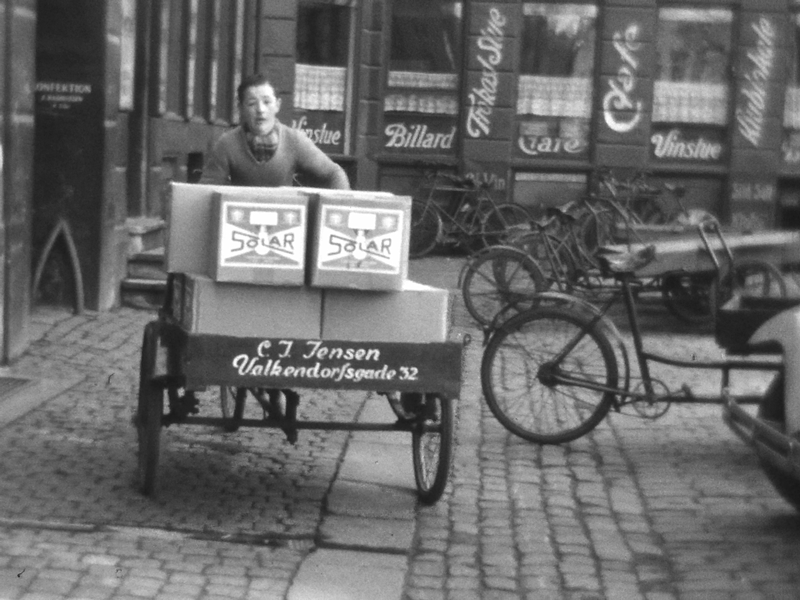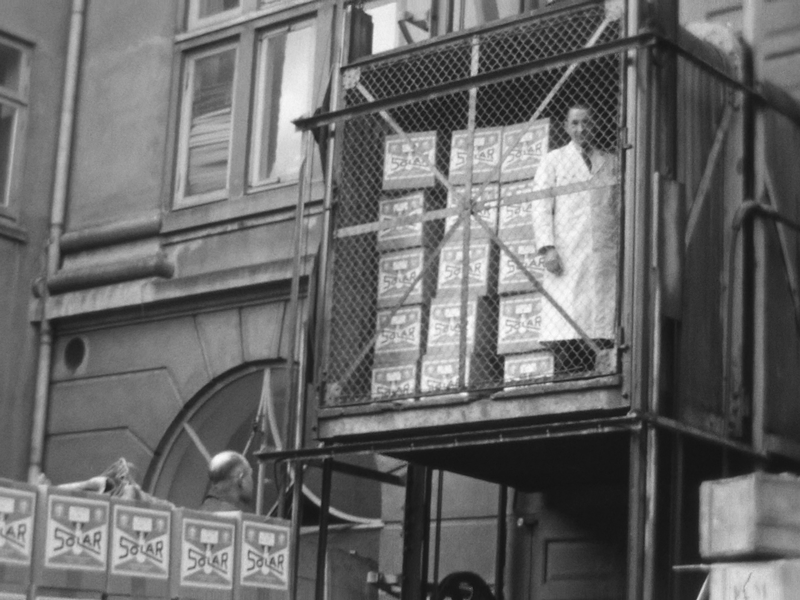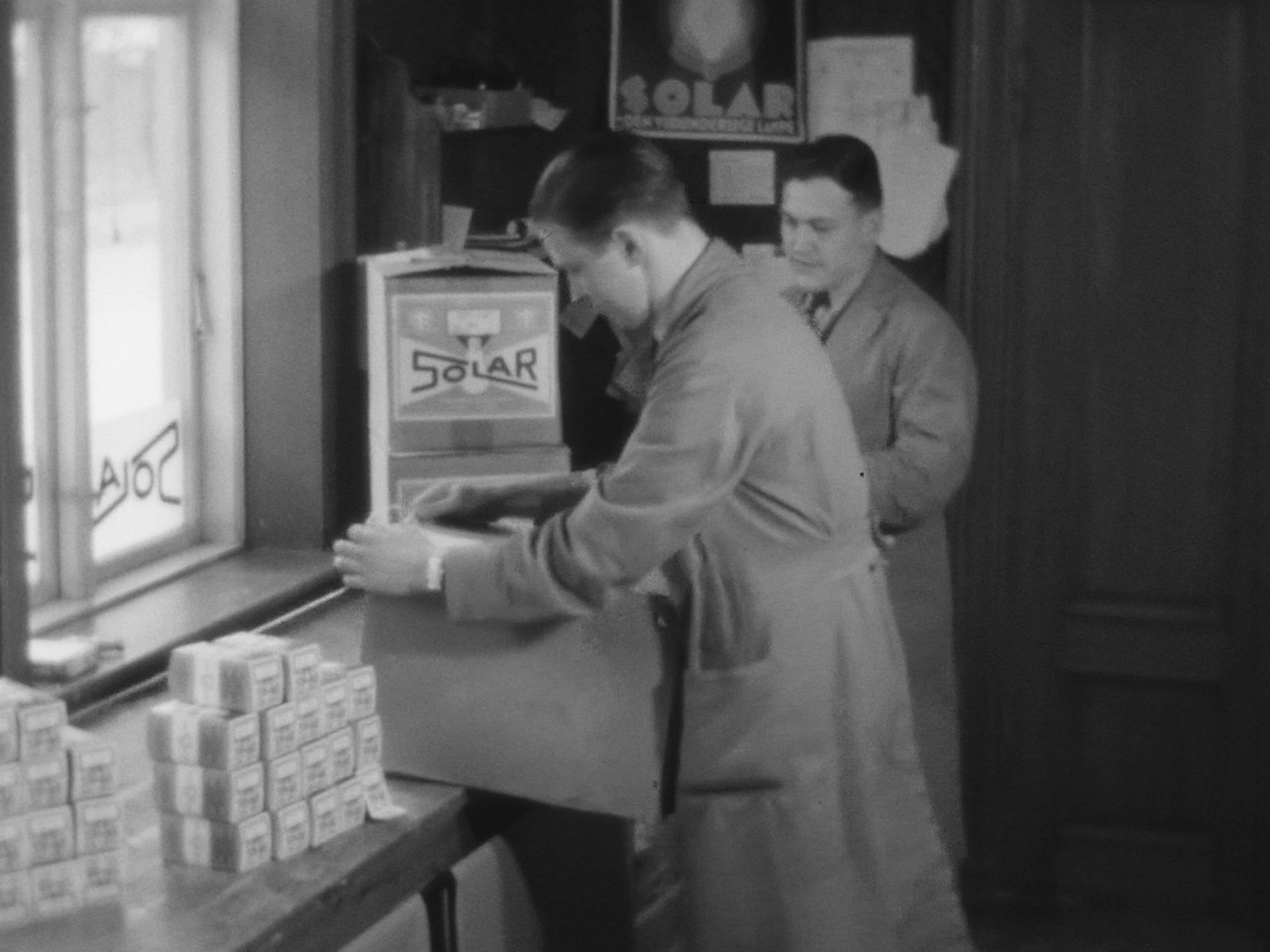Our offices in the 1930s
Celebratory cigars are handed out as the distribution of the Solar Lamp is a reality. This video shows how everyone works together at the different branches when the popular light bulb is delivered and unboxed.
Danish capital secures Danish jobs
In 1931, co-founder and majority shareholder in Aktieselskabet Nordisk Solar Compagni Jacob Jørgensen is known as one of Kolding’s most entrepreneurial businessmen. Despite the scarcity during the post-war years and the restrictions during the 1920s, he manages to develop the company from selling electric meters into a significant and acknowledged wholesaler of electrical articles and radios to electrical contractors as well as power and utility plants.
Now 40 years old, the merchant, consul and manufacturer goes by the name of Solar Jørgensen or just the ”Solarian” in the Kolding’s business network ”Kolding Fodsportsforening af 1915”. His testimonial says: ”The Solarian does not just follow others’ pace, he is often in front, going at his own pace, adaptable, showing the rest of us his will, courage and strength to carry his words into action that creates change”.
Global crisis makes Jacob Jørgensen focus on Danish production of incandescent lamps
The collapse of the American stock market and the historical stock market crash on 29 October 1929 – subsequently known as “black Tuesday” – quickly spreads to a global depression and financial crisis. When Denmark is hit by the crisis in 1931, the Danish government attempts to protect the country’s interests by enforcing increased duties and tightening import restrictions.
Jacob Jørgensen knows that the company’s purchasing and sales of imported goods might be paralysed by this, and he is particularly worried that it might affect the sale of incandescent lamps. He therefore immediately gets approval from the board to start looking into the possibilities of establishing Danish production of incandescent lamps. He knows that it will take time to get his own production in place and, in the meantime, he negotiates a purchase of 300,000 Solar-branded incandescent lamps from Nord Böhmischen Glühlampen Fabrik in Aussig in Germany.
With the company’s biggest purchase ever, Jacob Jørgensen secures three things: a large amount of incandescent lamps is produced under the Solar name (private label), the company gets a cost-competitive purchase price, and the ability to deliver is maintained until the Danish production is in place and able to take over.

A threat is turned into an opportunity
In the spring of 1931, the sale of the “Solar Lamp” commences. The brave but also excited managing director and the board are pleased to see that the sale goes extremely well in spite of the time of year. Within a few days, they sell around 20,000 lamps.
The high demand makes it possible for Solar to gain a foothold in Copenhagen. At the board meeting on 8 July 1931, Jacob Jørgensen announces an agreement with C.J. Jensen at Valkendorfsgade in Copenhagen, in which the company puts their sales office at Solar’s disposal. From here, Solar can direct the sales on Zealand, and for a 5 % commission, C.J. Jensen commits to selling the goods.

Scandinavian Incandescent Lamp Factory
Two months later, persistent Jacob Jørgensen announces that Solar has entered into a joint venture partnership with the engineering firm Due Petersen & Kryger in Svendborg with a view to establishing Danish production of incandescent lamps in the company Skandinavisk Glødelampefabrik (Scandinavian Incandescent Lamp Factory). As machines and production equipment has been ordered and will arrive from Berlin, he expects the factory in Svendborg to be operational in the beginning of 1932.
Spot the Solar sign on the side of a shop here in the streets of Nykøbing Falster
Large-scale marketing
Solar is the exclusive distributor and the only company carrying a stock of Skandinavisk Glødelampefabrik and is thereby obligated to handle all sales and marketing activities though their network of branches. In order to promote sales as much as possible, Solar receives a yearly marketing contribution of DKK 10,000 from Skandinavisk Glødelampefabrik.
From the beginning, advertising for the Solar Lamp is closely linked to the logo of the association Dansk Arbejde (Danish Work). Anywhere from the product’s packaging over catalogues, ads, posters, signs, big outdoor light signs to a number of promotion items, the Solar Lamp is marketed along with the theme “Danish work – Danish capital”.
Less than a year after Jacob Jørgensen becomes concerned about the global crisis and sees his business threatened by outside factors, duty barriers, and import restrictions, the branding of the Danish “Solar Lamp” now sheds a shining light on Nordisk Solar Compagni.
The fact that Nordisk Solar Compagni manages to grow and consolidate itself during a time when others have a hard time keeping up means that the entrepreneurial businessman once again makes both local and regional newspaper headlines.
2,500 incandescent lamps per day
Things go fast. The Solar Lamp quickly becomes a popular and very highly demanded commodity. Already in 1932, the daily production amounts to 2,500 incandescent lamps.
Ad from 1939
In 1933, the company is converted into a private limited company with Jacob Jørgensen as chairman of the board. The Solar Lamp becomes significant for the development of Solar’s business during the 1930s, when new branches open in Aalborg, Copenhagen, Esbjerg and Odense.
Following inevitable stagnation during the war years, the production of incandescent lamps ceases in 1946, and Jacob Jørgensen sells the machines and raw materials to factory owner Søren Madsen, Dansk Osram A/S.

Solar catalogue of electrical articles
Read more in the next chapter that will be published on 17 May 2019, which is the day when Solar turns 100.
The Castle
Take a look inside our headquarters "Borgen" in Kolding, Denmark back in the 1930s. We see Jacob Jørgensen in his office and the many employees that filled the halls and warehouse in Kolding.
Boxes and boxes of The Solar Lamp are stored and distributed from the headquarters as well as the separate external warehouse facility.
Production
Take a look behind the scenes and see how the production of The Solar Lamp took place. Both men and women worked at the factory where manufacturing and testing of the light bulbs took place. A bright place to work.
CV – Jacob Jørgensen
Kolding 1946
Personal data:
Name: Jacob Lauritz Jørgensen
Date of birth: Born 17 January 1891
Place of birth: Sønderborg, which at the time belonged under Germany
Civil status: Married in 1918 to Marie Andersen, Vamdrup
Children: Harald Preben Jørgensen (06.01.1918) and Edith Jørgensen (20.01.1920)
Address: Strandvejen 9 in Kolding
Education and professional experience:
1905 – 1906: Ship’s boy at the German school ship Potosi
1906 – 1909: Trains to be a ship constructing architect at shipyards in Flensburg and Eutin, Germany
1909 – 1910: Employed with Blom & Vos, Hamburg, and a power station in Hamburg
1910 – 1912: Employed as a sales representative and metrology expert with Solar Zähler Werke, Hamburg
01.02.1912: Immigrates to Denmark and represents the English company Solar Works
21.07.1913: Founder and manager of Solar Elektricitetsmaaleren v/ Pedersen & Jørgensen
17.05.1919: Founder and day-to-day manager of Nordisk Solar Compagni, Jernbanegade 19, Kolding
1919 - 1920: Receives trade licenses as merchant and manufacturer in Kolding
01.12.1924: Establishes the company Dansk Målerværksted, Kolding
1926 - 1928: Chairman of the business network Kolding Fodsportsforening af 1915
1927: Honorary Consul to Germany in Kolding
1929 - 1933: Member of the board of Kolding Sejlklub (yacht club)
23.12.1930: Managing Director of Aktieselskabet Nordisk Solar Compagni, Kolding
1931: Managing Director of Scandinavian Incandescent Lamp Factory in Kolding
1933: Chairman of the board of Scandinavian Incandescent Lamp Factory in Kolding
05.09.1934: Chairman of the board of A/S Kolding Ridehus (riding hall) at Dyrhavevej in Kolding
11.05.1935: Obtains Danish naturalisation and citizenship
1938: Managing Director of Audiola Radio, Kolding
Personal interests and qualifications:
Interests: Family, horses and riding, ships and yachting
Languages: Masters Danish (with an accent), German and English in writing and speech
Merchant: Has a distinct sense for great business acumen, is innovative and an initiator


